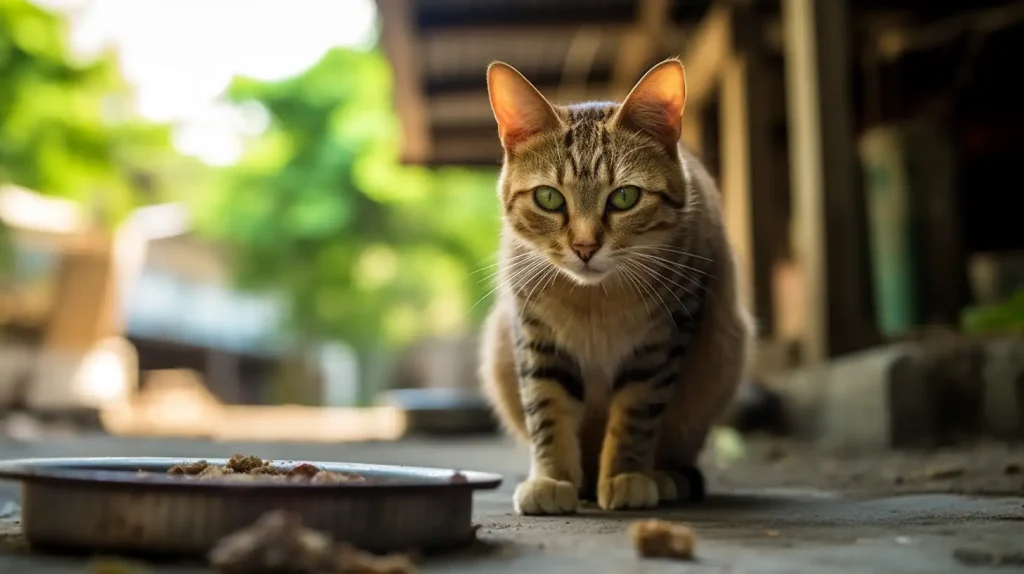Table of Contents
Key Takeaways
- When it comes to stray cat health, they face various including infectious diseases, nutritional deficiencies, and physical injuries.
- Feline Immunodeficiency Virus (FIV) and Feline Leukemia Virus (FeLV) weaken the immune system of stray cats.
- Rabies is a severe viral disease affecting the neurological system.
- Parasite control, spaying/neutering, and vaccination are crucial for improving stray cat health.
- Trap-Neuter-Return (TNR) programs help manage stray cat populations and reduce diseases.
- Providing nutrition, hydration, and safe shelters can greatly enhance stray cat well-being.
- Stray kittens require special care due to their vulnerability.
- Legal and ethical considerations play a role in addressing stray cat health.
- Advocacy and support for local animal welfare organizations can make a positive impact.
- Successful models worldwide highlight the effectiveness of community initiatives in improving stray cat health.
Every corner of our global neighborhood echoes with the soft padding of feline feet. These roaming felines, often termed as stray cats, have a life story very different from our beloved indoor companions. The story of stray cat health is one of resilience and survival, but it also encapsulates many challenges. By understanding the health issues faced by stray cats, we can play a pivotal role in their wellbeing and ultimately help foster a more compassionate world.
The Health Challenges of Stray Cats
Stray cats, by virtue of their exposure to the elements, face an array of health issues. These range from infectious diseases to nutritional deficiencies and physical injuries.
Feline Immunodeficiency Virus (FIV)
FIV weakens a cat’s immune system, rendering it susceptible to various secondary infections. A stray cat may appear healthy for years while being infected with FIV. However, during this period, the cat may spread the disease to others through deep bite wounds, a common occurrence during territorial disputes.
Feline Leukemia Virus (FeLV)
FeLV is another retrovirus that can compromise a cat’s immune system, often leading to anemia or lymphoma. It is transmitted through saliva and can spread quickly in close-knit cat communities.
Upper Respiratory Infections (URI)
Exposure to harsh weather and stress can make stray cats prone to URIs. Symptoms include sneezing, runny nose, and eye discharge. While these infections can often be treated, they pose a significant risk to vulnerable populations, especially kittens.
Parasites: Fleas, Ticks, and Worms
Stray cats are typically infested with various external and internal parasites. Fleas and ticks can transmit diseases and cause severe discomfort. Worms, such as roundworms, tapeworms, and hookworms, can lead to weight loss, anemia, and other health problems.
Malnutrition and Dehydration
Stray cats often struggle to find sufficient food and clean water, leading to malnutrition and dehydration. This can result in a weakened immune system, making them more susceptible to illnesses.
Dental Diseases
Poor diet and lack of dental care often lead to dental diseases in stray cats. Dental issues can cause pain, difficulty in eating, and can lead to other serious health problems if left untreated.

Zoonotic Diseases
It’s important to acknowledge the mutual affection we share with our feline friends, but a healthy respect for our boundaries is equally essential. A significant part of this understanding relates to zoonotic diseases. These are diseases that can jump the species barrier and spread from cats to humans.
Toxoplasmosis
Consider toxoplasmosis, for instance, a disease caused by a tiny parasite known as Toxoplasma gondii. While it doesn’t usually cause severe symptoms in humans, it can pose risks to pregnant individuals or those with weakened immune systems. You’re more likely to contract this from undercooked meat or unwashed veggies than from a cat, but stray cats can shed these parasites in their feces, especially if they have a habit of hunting.
Rabies
Then there’s the rather infamous rabies, a viral disease causing severe neurological symptoms. It’s rare in most developed countries due to extensive pet vaccination programs, but exposure from a stray or unvaccinated cat, usually through a bite or scratch, can still occur.
Ringworm
Or take ringworm, a common skin infection caused by a fungus (not a worm, despite the name), which presents as a circular rash. It’s easily spread through direct contact with an infected animal’s skin or fur, and stray cats are often carriers.
Remember, this isn’t about creating unnecessary fear but promoting responsible interactions. Simple measures like avoiding direct contact with stray cats, washing hands after potential exposure, and ensuring your own pets are regularly dewormed and vaccinated can help keep everyone safe and healthy. Knowledge truly is the best line of defense when it comes to zoonotic diseases.
Prevention and Treatment of Common Diseases
Tackling the issue of common diseases in stray cats isn’t just about identifying the problems, but also about understanding and applying effective prevention and treatment strategies. Just imagine, if our feline friends could talk, they’d probably say, “an ounce of prevention is worth a pound of cure.”
Vaccination
For starters, vaccination is a cornerstone of preventive healthcare. Vaccines for FIV, FeLV, and common respiratory diseases can drastically reduce disease incidence. However, administering vaccines to stray cats requires a strategic approach, often linked with TNR programs.
Parasite Control
Next up, parasite control. Regular treatment with broad-spectrum anti-parasitic medications can help keep nasty fleas, ticks, and worms at bay. Simple interventions like these can significantly improve the quality of life for a stray cat.
Spaying and Neutering
As for disease prevention, don’t forget about the power of spaying and neutering. By reducing aggressive behaviors and territorial fights, neutering decreases the risk of injury and subsequent infection, not to mention the spread of diseases like FIV, which are transmitted through deep bite wounds.
When it comes to treatment, that’s where things get a little tricky. Stray cats are not always easily approachable, and providing ongoing care can be a challenge. However, basic treatment, often through feeding medications, can be successful for less severe conditions and illnesses. For more serious health issues, it might be necessary to seek help from animal welfare organizations or local veterinary clinics, many of which offer reduced rates for caring for stray animals.
Navigating the world of stray cat health may seem daunting, but remember, every little bit helps. Each step taken towards disease prevention and treatment opens up a path to a healthier, happier life for these resilient felines.
Mental Health of Stray Cats
Life on the streets is tough, and while it takes a toll on a cat’s physical health, it also impacts their mental wellbeing. Imagine being constantly on alert, watching out for potential dangers, or searching for your next meal. This continuous stress can lead to chronic anxiety and fear in stray cats. What might this look like? Well, it could manifest as over-grooming to the point of bald patches, changes in eating habits, increased aggression, or simply withdrawal from social interactions.
Why does this matter?
You see, just like in humans, prolonged stress can weaken a cat’s immune system, making them more susceptible to diseases. It can also affect their appetite and sleep, further impacting their overall health. So, when we talk about stray cat health, let’s not forget that their emotional wellbeing is just as important as their physical health. As communities and cat lovers, we can make a difference by not just addressing their tangible needs, but also by creating environments that offer them a sense of safety and stability, reducing their stress and promoting healthier, happier lives.

Influence of Environment on Stray Cat Health
The environment plays a substantial role in determining stray cat health. Weather extremes can cause hypothermia or heatstroke. Urban environments present threats like traffic accidents, while rural settings might expose cats to predators or poisonous substances. Human interaction, though often well-meaning, can sometimes pose risks such as unintentional harm or disease transmission.
The Impact of Human and Wildlife Interaction
A closer look at a stray cat’s daily life reveals an intricate web of interactions that significantly shape their wellbeing. This interaction isn’t just with humans who might offer a scrap of food or a gentle pat, but also with a range of other animals.
Cat-to-Cat Encounters
Cats are known for their territorial behavior, and any encroachment by another cat can lead to fights. These encounters can result in physical injuries and the transmission of diseases such as FIV or FeLV. Moreover, overcrowding can lead to higher stress levels, which can adversely impact a cat’s immune system, making it more susceptible to various illnesses.
Interaction with Dogs and Wildlife
Dogs can be a significant threat, especially in urban areas. Stray cats also frequently cross paths with wildlife, which can result in the spread of certain diseases, injuries, or even predation. For instance, interaction with raccoons can expose cats to diseases like rabies.
Human Interaction
Humans, too, significantly impact stray cat health—both positively and negatively. While many kind-hearted individuals offer food, shelter, or medical care, others may pose a threat due to intolerance, fear, or simple negligence. Exposure to human pollution or toxins can also have dire consequences on their health.
Understanding these complex interactions offers us invaluable insights into the diverse challenges that stray cats face and underscores the need for compassionate and effective community-wide initiatives to improve their overall wellbeing.
Evaluating Stray Cat Health
Being able to assess the health of a stray cat can go a long way in providing timely help. Signs of health issues can include changes in behavior, visible injuries, unusual discharge from the eyes or nose, weight loss, or poor coat condition. Body condition scoring is a useful tool for assessing a cat’s general health and nutritional status. Whenever possible, a veterinary check-up can help identify and address health issues that may not be immediately apparent.
Strategies for Improving Stray Cat Health
Improving stray cat health requires concerted efforts at multiple levels.
Trap-Neuter-Return (TNR) Programs
TNR programs play a critical role in managing stray cat populations, thereby reducing competition for resources and the spread of diseases. Neutering also reduces aggressive behavior in cats, lowering the risk of injury.
Importance of Vaccination
Vaccinations are a preventative measure that can protect stray cats from several common, serious diseases. They play a crucial role in overall population health.
Accessible Sources of Nutrition and Hydration
Providing stray cats with regular access to clean water and balanced meals can significantly improve their health and quality of life.
Creating Safe and Warm Shelters
Simple, inexpensive shelters can provide stray cats with much-needed refuge from weather extremes and potential threats.
Community Awareness and Participation
Awareness programs can help communities understand the challenges faced by stray cats and how individuals can contribute to their wellbeing.
Fostering and Adoption of Stray Cats
For anyone considering expanding their family with a feline companion, fostering or adopting a stray cat can be a rewarding experience filled with love and joy. Yet, it’s important to understand that this process also comes with its set of responsibilities and challenges.
The Process
Fostering involves temporarily caring for a stray cat until a permanent home can be found for them. Many animal rescue organizations run foster programs, providing the necessary supplies and medical care for the cat, while the foster parent provides the love and attention the cat needs. Adoption, on the other hand, is a lifelong commitment where you become the forever home for the cat. This involves providing for their every need—nutrition, healthcare, and emotional well-being—throughout their life.
Benefits
The biggest reward of fostering or adopting a stray cat is the unquantifiable love and companionship these wonderful creatures offer. Not only do you get a furry friend, but you also contribute positively to the community by reducing the number of homeless cats. Moreover, studies show that pets can improve our mental health and lower stress levels, adding a wellness bonus to the whole experience.
Challenges
Despite the rewarding nature of fostering or adopting, potential challenges can arise. Stray cats, especially adult ones, may require time to adjust to a home environment, which requires patience and understanding from their human caregivers. They may also have health issues that require medical attention. Furthermore, if you’re fostering, saying goodbye when your furry friend finds their forever home can be bittersweet.
In the end, whether you choose to foster or adopt, opening your heart and home to a stray cat is a testament to the human capacity for compassion, turning the tale of a once-homeless feline into a story of hope and love.
The Role of Animal Shelters and Rescue Groups
Stepping up as guardians of the urban jungle, animal shelters and rescue groups play an indispensable role in the tapestry of stray cat health. These organizations shoulder the Herculean task of providing medical aid, nourishment, and affection to countless cats that roam our streets. Be it a kitten left to fend for itself or an elderly cat injured in a squabble, their doors are always open. Not only do they rescue and rehabilitate, but they also tirelessly work towards a long-term solution – finding these feline friends loving homes where they can enjoy the comfort and security they deserve.
Moreover, they play a significant role in the TNR programs, helping to control the stray cat population. Animal shelters and rescue groups also advocate for the rights of these often overlooked citizens, pushing for changes in local and national policies. Through their work, they educate the public about the importance of compassionate cohabitation with our feline neighbors. Their tireless efforts reflect a reality where humanity and nature learn to share the urban space gracefully, creating a future where every purr resonates with contentment and every tail flick is a tale of survival and triumph.
Special Considerations for Stray Kittens
Stray kittens face additional challenges due to their underdeveloped immune systems and lack of maternal care. They require proper nutrition for growth, deworming to prevent internal parasites, and socialization to increase their chances of adoption.

Legal and Ethical Issues Surrounding Stray Cat Health
Stray cats inhabit the murky zone between pet and wildlife, often leading to complex legal and ethical considerations. While feeding and caring for stray cats is generally seen as a compassionate act, it may be restricted or regulated in some areas due to concerns about overpopulation and disease transmission. The ethical obligations towards stray cats and the best methods to manage their populations are subjects of ongoing debate. Advocacy for humane policies and support for animal welfare organizations play a significant role in ensuring stray cat health.
Laws and Regulations
Navigating the labyrinth of laws and regulations around stray cats can seem like herding cats itself! But fear not, as we can simplify some of the basics. Laws surrounding stray cat health and welfare can vary dramatically from one jurisdiction to another. For instance, in certain places, feeding stray cats is a legal act of compassion, while in others, it may be frowned upon or even penalized due to concerns about overpopulation and disease spread. Similarly, TNR practices are widely accepted and promoted in some areas but face legal restrictions in others. Even the definition of ownership can be fuzzy when it comes to cats. In many jurisdictions, you could become the legal owner of a stray cat just by providing care, which may then subject you to responsibilities and potential liabilities. These wide variations underscore the importance of familiarizing oneself with local laws when seeking to improve the lives of our feline friends. When in doubt, it’s always a good idea to consult with a local animal welfare organization or legal advisor.
Ethical Debates
When it comes to our feline friends who wander the streets, few topics are as emotionally charged as the ethical debates surrounding their care. Among these, TNR, euthanasia, and feeding bans often stand out.
Trap-Neuter-ReturnTNR
On one hand, proponents of TNR programs argue that it’s a humane method to control stray cat populations, curb aggressive behaviors, and decrease disease transmission. However, some critics point out that TNR doesn’t always ensure a better quality of life for cats who still have to brave the elements and face potential dangers in their environment post-release.
Euthanasia
Euthanasia is a deeply emotional and complex issue. In certain cases, it’s seen as a last resort when a cat is severely ill or injured with no hope for recovery. However, its use as a means of population control is highly controversial. Animal rights advocates argue for a life’s inherent value, emphasizing that alternatives like TNR and adoption should be prioritized.
Feeding Bans
Feeding bans also create quite a stir. Critics argue that denying cats food can lead to malnutrition and spread of diseases due to weakened immune systems. Supporters, on the other hand, believe that feeding bans discourage cat overpopulation and reduce nuisances or potential risks to local wildlife and human communities.
In essence, these debates serve to remind us that the journey to improve the lives of stray cats isn’t a one-size-fits-all solution. It’s a nuanced process that requires balancing compassion, practicality, and ethical considerations.
Role of Activism and Advocacy
In the intricate world of stray cat health, activism and advocacy have carved a niche of their own. Animal rights advocates stand at the forefront of this battle, pushing for reforms and providing a voice to these silent felines. Their efforts play an essential role in influencing policy change and galvanizing public support. From organizing TNR programs, challenging inhumane practices, lobbying for stronger animal welfare laws, to running awareness campaigns on social media, these champions of change ensure that the concerns of stray cats remain in the public eye. The transformative power of activism lies not just in the big strides, but also in the small steps each of us can take. Advocacy can begin with the simple act of sharing accurate information about stray cats in our communities, or supporting local animal welfare organizations. Remember, every whisper can contribute to a roar of change, each of us has the capacity to positively influence the world of stray cat health.
Case Study: Successful Models of Stray Cat Health Management
Across the globe, several communities have pioneered successful initiatives to improve stray cat health. These models serve as an inspiration and provide valuable insights into what can be achieved with planning, collaboration, and determination.
Stray Cat Health – Conclusion
Addressing the health challenges faced by stray cats requires a multi-faceted approach involving prevention, vaccination, and community initiatives. By promoting responsible pet ownership and supporting local animal welfare organizations, we can make a positive impact on stray cat health. Together, let us strive for a world where every stray cat receives the care they deserve and where their well-being is prioritized.
FAQs
Q: What are the most common health issues among stray cats? A: Stray cats often face a variety of health issues, such as infectious diseases like Feline Immunodeficiency Virus (FIV) and Feline Leukemia Virus (FeLV), Upper Respiratory Infections (URIs), and infestations with parasites like fleas, ticks, and worms. They also commonly suffer from malnutrition, dehydration, and dental diseases.
Q: How does the environment impact stray cat health? A: The environment significantly influences stray cat health. For example, harsh weather conditions can lead to hypothermia or heatstroke. Urban environments may pose dangers from traffic, while rural areas might expose cats to predators or toxic substances. Interaction with humans, while often beneficial, can also sometimes pose risks.
Q: How can I assess the health of a stray cat? A: Look for visible signs such as changes in behavior, visible injuries, unusual discharge from the eyes or nose, weight loss, or poor coat condition. A body condition scoring system can also be a useful tool for health assessment. However, a professional check-up by a vet is recommended whenever possible.
Q: What steps can be taken to improve stray cat health? A: Several strategies can contribute to improving stray cat health, including Trap-Neuter-Return (TNR) programs, vaccination, providing accessible nutrition and hydration, creating safe and warm shelters, and fostering community awareness and participation.
Q: How do legal and ethical issues affect stray cat health? A: Legal regulations in certain areas may restrict activities like feeding or caring for stray cats due to concerns about overpopulation and disease transmission. Ethical debates often revolve around managing stray cat populations humanely. Advocacy for more compassionate policies and support for animal welfare organizations play significant roles in influencing stray cat health.
Q: What are some successful models of stray cat health management? A: Many communities around the globe have successfully implemented initiatives to improve stray cat health. These often involve TNR programs, mass vaccination drives, community feeding programs, provision of shelters, and public education about stray cats.
Q: What special considerations are there for stray kittens? A: Stray kittens face additional challenges due to their underdeveloped immune systems and lack of maternal care. They require proper nutrition, deworming, and early socialization to increase their chances of adoption.
Q: What is the role of activism and advocacy in stray cat health? A: Activism and advocacy can help to drive policy changes, raise public awareness, and foster community action for stray cat health. Advocates work at various levels, from challenging inhumane practices and lobbying for better animal welfare laws to running awareness campaigns and supporting local animal welfare organizations.



